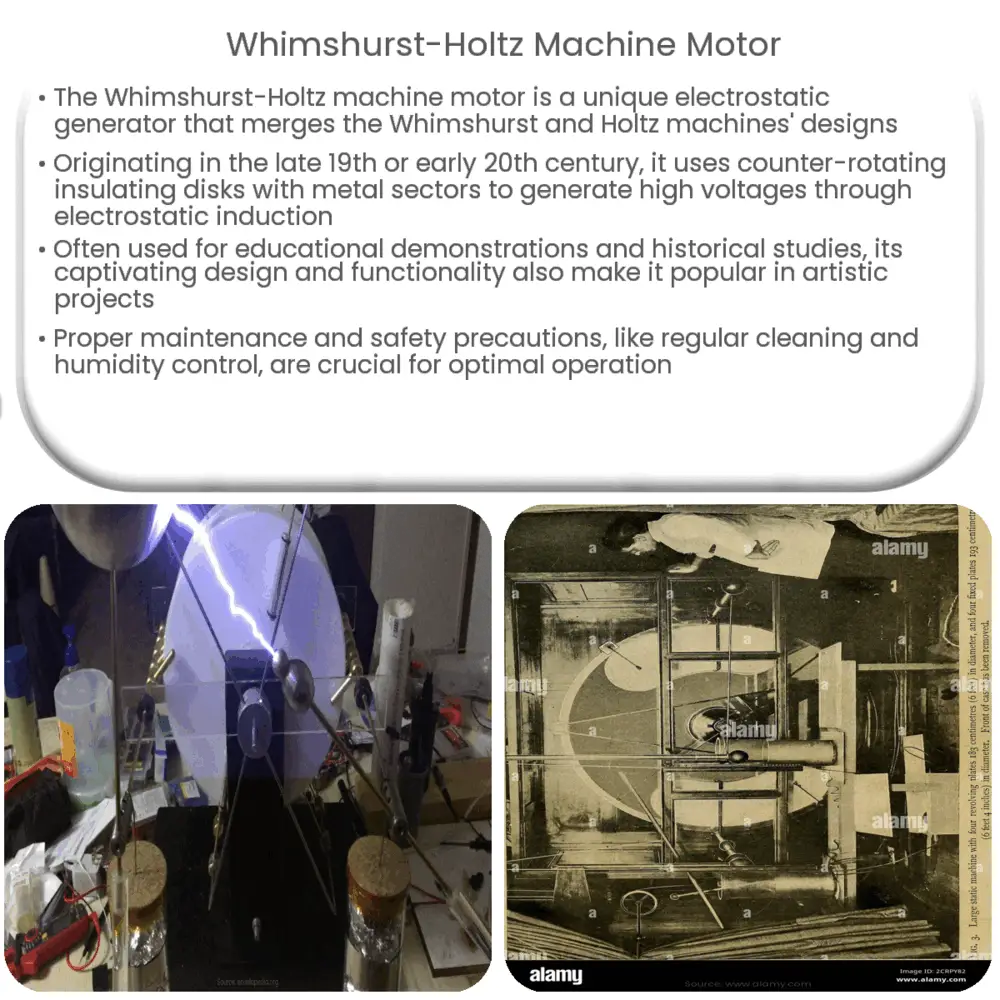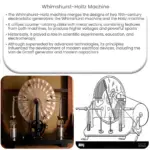The Whimshurst-Holtz machine motor is a unique electrostatic generator, combining the Whimshurst and Holtz machines, used for educational demonstrations and research.

Whimshurst-Holtz Machine Motor: A Comprehensive Overview
Introduction
The Whimshurst-Holtz machine motor is an intriguing and lesser-known electrostatic generator, which combines the design principles of two famous devices: the Whimshurst machine and the Holtz machine. Invented in the 19th century, these machines were instrumental in the development of early electrical and electrostatic experiments. This article delves into the fascinating world of Whimshurst-Holtz machine motors, exploring their history, design, working principles, and applications.
Historical Background
The Whimshurst-Holtz machine motor has its roots in two influential devices. The Whimshurst machine, invented by the British inventor James Whimshurst in 1880, was a popular electrostatic generator used for generating high voltages. It was well-known for its simplicity, efficiency, and reliability. On the other hand, the Holtz machine was invented by the German physicist Wilhelm Holtz in 1865. Although less common, it was a precursor to the Whimshurst machine and also generated high voltages through electrostatic induction.
Combining the principles of these two devices, the Whimshurst-Holtz machine motor was developed as a way to maximize their strengths and overcome their individual limitations. While there is no specific date or inventor associated with the creation of the Whimshurst-Holtz machine motor, it is believed to have been developed sometime in the late 19th or early 20th century.
Design and Construction
The Whimshurst-Holtz machine motor shares many design features with its parent machines. The most notable similarity is the presence of two large, counter-rotating disks made of an insulating material like glass or hard rubber. The disks are mounted on a common axis, with one disk representing the Whimshurst machine and the other representing the Holtz machine.
Each disk has metal sectors attached to its surface, which are evenly spaced around its circumference. The Whimshurst disk’s sectors are connected to brushes that transfer charge to Leyden jars, which store the generated electricity. The Holtz disk’s sectors, on the other hand, are connected to brushes that transfer charge to inductors, which are used to induce charge on the Whimshurst disk’s sectors.
A key difference between the Whimshurst-Holtz machine motor and its parent devices is the addition of a motor, which drives the rotation of the disks. This allows for continuous and stable operation, resulting in more reliable and efficient voltage generation.
Working Principles
The Whimshurst-Holtz machine motor operates on the principle of electrostatic induction, similar to its parent devices. When the disks rotate, the metal sectors on the Holtz disk pass by the inductors, inducing charges on them. These charges are then transferred to the metal sectors on the Whimshurst disk, which are connected to the Leyden jars. The accumulation of charges in the Leyden jars leads to a high voltage difference between them, which can be discharged as a spark or used to power various electrical devices.
By combining the designs of the Whimshurst and Holtz machines, the Whimshurst-Holtz machine motor is able to generate higher voltages with increased efficiency compared to its parent devices. This makes it an appealing choice for electrostatic experiments and demonstrations.
Applications and Uses
Although the Whimshurst-Holtz machine motor may not be as widely used as it once was, it still holds a special place in the world of science and education. Its main applications include:
- Educational demonstrations: The Whimshurst-Holtz machine motor is often used in classrooms and science museums to demonstrate the principles of electrostatic induction and charge generation. Its visually striking design and ability to produce impressive sparks make it an engaging and memorable educational tool.
- Research and experimentation: In the early days of electrical research, the Whimshurst-Holtz machine motor played a crucial role in conducting experiments on electrostatics, high voltages, and electrical discharges. While modern technology has surpassed it in many ways, the machine remains a valuable piece of scientific history and is sometimes used by enthusiasts and researchers for niche applications and historical studies.
- Art and design: The Whimshurst-Holtz machine motor, with its eye-catching appearance and fascinating operation, has found its way into various artistic and design projects. This includes steampunk installations, kinetic sculptures, and other creative endeavors that pay tribute to the machine’s historical and scientific significance.
Maintenance and Safety
Operating a Whimshurst-Holtz machine motor requires proper maintenance and safety precautions. Some important considerations include:
- Inspection: Before each use, the machine should be inspected for any signs of damage or wear. This includes checking the integrity of the disks, metal sectors, brushes, and other components. Damaged or worn parts should be replaced to ensure safe and efficient operation.
- Cleaning: Keeping the machine clean is essential for optimal performance. Dust and dirt can accumulate on the disks, brushes, and other components, which may interfere with the electrostatic induction process. Regular cleaning with a soft, dry cloth is recommended to remove any build-up.
- Humidity: The Whimshurst-Holtz machine motor is sensitive to humidity, as moisture in the air can reduce its efficiency and cause erratic operation. Operating the machine in a dry environment or using a dehumidifier can help mitigate this issue.
- Safety precautions: When working with high voltages, safety should always be a top priority. Protective equipment such as insulating gloves and safety goggles should be worn, and the machine should be operated at a safe distance from flammable materials and electronic devices.
Conclusion
The Whimshurst-Holtz machine motor is a fascinating combination of two pioneering electrostatic generators, boasting an impressive design and captivating operation. Although its practical applications have diminished over time, the machine remains an important piece of scientific history and continues to captivate audiences in educational, artistic, and experimental settings. By understanding its principles, design, and proper maintenance, users can safely explore the captivating world of electrostatics and high voltages with this remarkable device.




